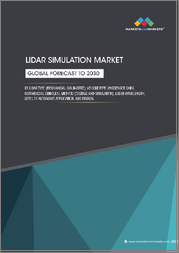
|
시장보고서
상품코드
1775333
세계의 MEMS LiDAR 시장 예측(2025-2030년)MEMS LiDAR Market - Forecasts from 2025 to 2030 |
||||||
세계의 MEMS LiDAR 시장은 2025년 10억 6,400만 달러에서 2030년까지 27억 1,700만 달러로 성장해, CAGR 20.62%를 보일 것으로 예측됩니다.
MEMS LiDAR 시장은 다른 레이저 스캐너에 비해 컴팩트한 사이즈, 고속성, 비용효과에 견인되어 안정된 성장이 예상되고 있습니다.
시장 성장 촉진요인
자동차 분야 수요
자동차산업은 자율주행차에 대한 수요 증가에 힘입어 MEMS LiDAR 시장의 주요 성장 요인이 되고 있습니다. MEMS 기술에 의해 소형으로 저렴한 LiDAR 센서의 제조가 가능하게 되어, BMW나 Volvo 등의 주요 제조업체가 운전의 안전성을 높이기 위해 탑재하는 케이스가 늘어나고 있습니다. 예를 들어, MEMS 솔리드 스테이트 LiDAR인 RoboSense의 RS-LiDAR-M1은 VDA6.3, IATF16949, ISO26262, ISO16750등의 엄격한 규격에 준거하고 있어 지능형 차량의 다양한 기상 조건 아래에서의 신뢰성을 확보하고 있습니다.
제품 혁신은 시장 성장을 더욱 가속화합니다. 2023년에는 Mercedes Benz의 Drive Pilot 기술이 레벨 3 자율주행으로 인정되어 차량이 시속 37마일까지의 속도로 운전 태스크를 처리할 수 있게 되어 첨단 LiDAR 시스템의 통합을 보여줍니다. General Motors의 Ultra Cruise ADAS 기술은 사고 제로, 배출 가스 제로, 정체 제로라는 목표를 달성하기 위해 MEMS LiDAR을 활용하고 있습니다.
우주에의 응용
MEMS LiDAR의 수십 나노미터 공차를 가진 고정밀 광학 시스템은 우주 용도에서 높은 충실도의 빔 스캐닝에 필수적인 신속한 튜닝과 정확한 광 위상 제어를 가능하게 합니다. LiDAR은 에너지 소비를 줄이고 관측 정확도를 향상시킬 수 있기 때문에 우주 프로젝트에서 경제적으로 실현 가능합니다.
지리적 전망
북미가 MEMS LiDAR 시장을 독점할 것으로 예상되며 자율주행차 수요의 급증과 자동차 생산 증가에 의해 뒷받침되고 있습니다.
MEMS LiDAR 시장은 자동차 및 우주 용도에 견인되었으며, 북미는 기술 및 생산의 진보에 따라 주도하고 있으며 확대가 예상됩니다.
이 보고서의 주요 이점
- 인사이트가 풍부한 분석 : 고객 부문, 정부 정책 및 사회 경제 요인, 소비자 선호, 산업별 및 기타 하위 부문에 중점을 두고 주요 지역 및 신흥 지역을 다루는 상세한 시장 인사이트를 얻을 수 있습니다.
- 경쟁 구도 : 세계의 주요 기업이 채용하는 전략적 전략을 이해하고 적절한 전략에 의한 시장 침투 가능성을 이해할 수 있습니다.
- 시장 동향과 촉진요인 : 다이나믹한 요인과 매우 중요한 시장 동향, 그리고 그것들이 향후 시장 개척을 어떻게 형성해 나갈까를 찾습니다.
- 행동 가능한 제안: 인사이트를 전략적 의사 결정에 활용해, 역동적인 환경 속에서 새로운 비즈니스 스트림과 수익을 발굴합니다.
- 폭넓은 이용자에 대응: 신흥기업, 연구기관, 컨설턴트, 중소기업, 대기업에 있어서 유익하고 비용효과가 높습니다.
어떤 용도로 사용됩니까?
업계 및 시장 인사이트, 사업 기회 평가, 제품 수요 예측, 시장 진출 전략, 지리적 확대, 설비 투자 결정, 규제 프레임워크과 영향, 신제품 개척, 경쟁의 영향
조사 범위
- 2022-2024년 과거 데이터 및 2025-2030년 예측 데이터
- 성장 기회, 과제, 공급망 전망, 규제 틀 및 동향 분석
- 경쟁자 포지셔닝, 전략 및 시장 점유율 분석
- 수익 성장과 예측 국가를 포함한 부문 및 지역 분석
기업 프로파일
목차
제1장 주요 요약
제2장 시장 현황
- 시장 개요
- 시장의 정의
- 조사 범위
- 시장 세분화
제3장 비즈니스 상황
- 시장 성장 촉진요인
- 시장 성장 억제요인
- 시장 기회
- Porter's Five Forces 분석
- 업계 밸류체인 분석
- 정책 및 규정
- 전략적 제안
제4장 기술 전망
제5장 MEMS LiDAR 시장 : 컴포넌트별
- 소개
- 송신기
- 수신기
제6장 MEMS LiDAR 시장 : 파장별
- 소개
- 905 Nm
- 1550 Nm
제7장 MEMS LiDAR 시장 : 기술별
- 소개
- 2D MEMS LiDAR
- 3D MEMS LiDAR
제8장 MEMS LiDAR 시장 : 최종 사용자별
- 소개
- 자동차
- 항공우주 및 방어
- 가전
- 기상학
- 기타
제9장 MEMS LiDAR 시장 : 지역별
- 소개
- 북미
- 미국
- 캐나다
- 멕시코
- 남미
- 브라질
- 아르헨티나
- 기타
- 유럽
- 독일
- 프랑스
- 영국
- 스페인
- 기타
- 중동 및 아프리카
- 사우디아라비아
- 아랍에미리트(UAE)
- 기타
- 아시아태평양
- 중국
- 인도
- 일본
- 한국
- 인도네시아
- 기타
제10장 경쟁 환경과 분석
- 주요 기업과 전략 분석
- 시장 점유율 분석
- 합병, 인수, 합의 및 협업
- 경쟁 대시보드
제11장 기업 프로파일
- RoboSense Technology Co Ltd
- Jenoptik AG
- Blickfeld GmbH
- Pioneer Corporation
- Innovize
- Microvision Inc.
- Draper
- Mitsubishi Electric Corporation
제12장 부록
- 통화
- 전제조건
- 기준연도과 예측연도의 타임라인
- 이해 관계자에게 있어서의 주요 이점
- 조사 방법
- 약어
The MEMS LiDAR market is expected to grow from USD 1.064 billion in 2025 to USD 2.717 billion in 2030, at a CAGR of 20.62%.
The MEMS LiDAR market is poised for steady growth, driven by its compact size, high speed, and cost-effectiveness compared to other laser scanners. MEMS mirror-based LiDAR systems are evaluated using a figure of merit based on aperture size, field of view, and resonant frequency, highlighting their suitability for diverse applications, particularly in automotive and space sectors.
Market Drivers
Automotive Sector Demand
The automotive industry is a key growth driver for the MEMS LiDAR market, fueled by the rising demand for autonomous vehicles. MEMS technology enables the production of compact, affordable LiDAR sensors, which are increasingly integrated by major manufacturers like BMW and Volvo to enhance driving safety. Technological advancements, including adaptive algorithms, high-definition mapping, and improved sensor processing, have spurred the production of autonomous vehicles reliant on LiDAR. For example, RoboSense's RS-LiDAR-M1, a MEMS solid-state LiDAR, adheres to rigorous standards like VDA6.3, IATF16949, ISO26262, and ISO16750, ensuring reliability in varied weather conditions for intelligent vehicles.
Product innovations further accelerate market growth. In 2023, Mercedes Benz's Drive Pilot technology, certified for Level 3 autonomous driving, enables vehicles to handle driving tasks at speeds up to 37 mph, showcasing the integration of advanced LiDAR systems. Similarly, Innoviz's MEMS-based LiDAR sensor, debuted with BMW's Seven series in 2022, underscores the industry's shift toward high-performance, compact solutions. General Motors' Ultra Cruise ADAS technology also leverages MEMS LiDAR to advance its goals of zero accidents, emissions, and traffic congestion.
Space Applications
MEMS LiDAR's precision optics, with tolerances in the tens of nanometers, enable rapid tuning and precise light phase control, critical for high-fidelity beam scanning in space applications. These capabilities reduce energy consumption and enhance observational accuracy, making MEMS LiDAR financially viable for space projects. The growing aeronautical industry, marked by increased budgets for space research, further drives demand for MEMS LiDAR in astronomical and space exploration applications.
Geographical Outlook
North America is expected to dominate the MEMS LiDAR market, propelled by the surge in autonomous vehicle demand and increased automotive production. The U.S. benefits from significant investments in technologies like high-definition mapping and adaptive algorithms, fostering the development of cost-effective, compact LiDAR systems. These advancements support the expansion of autonomous vehicle production, boosting MEMS LiDAR adoption.
The MEMS LiDAR market is set to expand, driven by automotive and space applications, with North America leading due to technological and production advancements.
Key Benefits of this Report:
- Insightful Analysis: Gain detailed market insights covering major as well as emerging geographical regions, focusing on customer segments, government policies and socio-economic factors, consumer preferences, industry verticals, and other sub-segments.
- Competitive Landscape: Understand the strategic maneuvers employed by key players globally to understand possible market penetration with the correct strategy.
- Market Drivers & Future Trends: Explore the dynamic factors and pivotal market trends and how they will shape future market developments.
- Actionable Recommendations: Utilize the insights to exercise strategic decisions to uncover new business streams and revenues in a dynamic environment.
- Caters to a Wide Audience: Beneficial and cost-effective for startups, research institutions, consultants, SMEs, and large enterprises.
What do businesses use our reports for?
Industry and Market Insights, Opportunity Assessment, Product Demand Forecasting, Market Entry Strategy, Geographical Expansion, Capital Investment Decisions, Regulatory Framework & Implications, New Product Development, Competitive Intelligence
Report Coverage:
- Historical data from 2022 to 2024 & forecast data from 2025 to 2030
- Growth Opportunities, Challenges, Supply Chain Outlook, Regulatory Framework, and Trend Analysis
- Competitive Positioning, Strategies, and Market Share Analysis
- Revenue Growth and Forecast Assessment of segments and regions including countries
Company Profiling (Strategies, Products, Financial Information, and Key Developments among others.
MEMS LiDAR Market Segmentation
By Component
- Transmitter
- Receiver
By Wavelength
- 905 Nm
- 1550 Nm
By Technology
- 2D MEMS LiDAR
- 3D MEMS LiDAR
By End-User
- Automotive
- Aerospace & Defense
- Consumer Electronics
- Meteorology
- Others
By Geography
- North America
- United States
- Canada
- Mexico
- South America
- Brazil
- Argentina
- Others
- Europe
- United Kingdom
- Germany
- France
- Spain
- Others
- Middle East and Africa
- Saudi Arabia
- UAE
- Israel
- Others
- Asia Pacific
- Japan
- China
- India
- South Korea
- Indonesia
- Taiwan
- Thailand
- Others
TABLE OF CONTENTS
1. EXECUTIVE SUMMARY
2. MARKET SNAPSHOT
- 2.1. Market Overview
- 2.2. Market Definition
- 2.3. Scope of the Study
- 2.4. Market Segmentation
3. BUSINESS LANDSCAPE
- 3.1. Market Drivers
- 3.2. Market Restraints
- 3.3. Market Opportunities
- 3.4. Porter's Five Forces Analysis
- 3.5. Industry Value Chain Analysis
- 3.6. Policies and Regulations
- 3.7. Strategic Recommendations
4. TECHNOLOGICAL OUTLOOK
5. MEMS LIDAR MARKET BY COMPONENT
- 5.1. Introduction
- 5.2. Transmitter
- 5.3. Receiver
6. MEMS LIDAR MARKET BY WAVELENGTH
- 6.1. Introduction
- 6.2. 905 Nm
- 6.3. 1550 Nm
7. MEMS LIDAR MARKET BY TECHNOLOGY
- 7.1. Introduction
- 7.2. 2D MEMS LiDAR
- 7.3. 3D MEMS LiDAR
8. MEMS LIDAR MARKET BY END-USER
- 8.1. Introduction
- 8.2. Automotive
- 8.3. Aerospace & Defense
- 8.4. Consumer Electronics
- 8.5. Meteorology
- 8.6. Others
9. MEMS LIDAR MARKET BY GEOGRAPHY
- 9.1. Introduction
- 9.2. North America
- 9.2.1. USA
- 9.2.2. Canada
- 9.2.3. Mexico
- 9.3. South America
- 9.3.1. Brazil
- 9.3.2. Argentina
- 9.3.3. Others
- 9.4. Europe
- 9.4.1. Germany
- 9.4.2. France
- 9.4.3. United Kingdom
- 9.4.4. Spain
- 9.4.5. Others
- 9.5. Middle East and Africa
- 9.5.1. Saudi Arabia
- 9.5.2. UAE
- 9.5.3. Others
- 9.6. Asia Pacific
- 9.6.1. China
- 9.6.2. India
- 9.6.3. Japan
- 9.6.4. South Korea
- 9.6.5. Indonesia
- 9.6.6. Others
10. COMPETITIVE ENVIRONMENT AND ANALYSIS
- 10.1. Major Players and Strategy Analysis
- 10.2. Market Share Analysis
- 10.3. Mergers, Acquisitions, Agreements, and Collaborations
- 10.4. Competitive Dashboard
11. COMPANY PROFILES
- 11.1. RoboSense Technology Co Ltd
- 11.2. Jenoptik AG
- 11.3. Blickfeld GmbH
- 11.4. Pioneer Corporation
- 11.5. Innovize
- 11.6. Microvision Inc.
- 11.7. Draper
- 11.8. Mitsubishi Electric Corporation
12. APPENDIX
- 12.1. Currency
- 12.2. Assumptions
- 12.3. Base and Forecast Years Timeline
- 12.4. Key benefits for the stakeholders
- 12.5. Research Methodology
- 12.6. Abbreviations



















